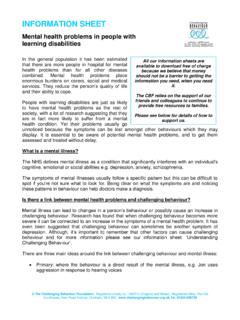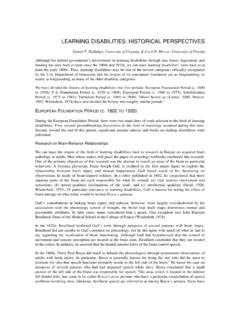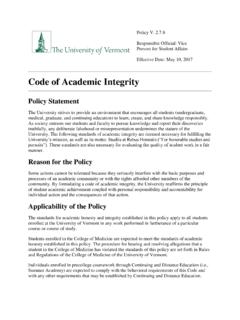Transcription of Social capital, social inclusion and services for …
1 disability & Society, Vol. 19, No. 3, May 2004 Social capital , Social inclusion andservices for people with learningdisabilitiesPeter Batesa* and Fabian A. DavisbaNational Development Team, Ipswich, UK;bBromley Mental Health services , OxleasNHS Trust, Chislehurst, Kent, UKBoth Social capital and Social inclusion have emerged as significant concepts for human servicesin the last decade and yet their inter-relationship remains largely unexplored. This article arguesthat, whilst they are similar in their vision for a healthy society, they adopt sufficiently differentperspectives to stimulate and challenge each other. This can be well illustrated by reference toservices for people with a learning disability . Commissioners and providers of learning disabilityservices are encouraged through this article to harness both concepts in order to assist in theprocess of modernizing services and increasing life opportunities for the people they support.
2 Itis argued that it is not possible to understand the full consequences of adopting either theoreticalposition without an adequate understanding of the other. Examples are given of the implicationsof this for advocacy services , day opportunities, rural communities, transition and staff concept of Social capital (Putnam, 2000) has become popular just as theEnglish White Paper Valuing People (Department of Health, 2001b) has requiredlearning disability services to work towards Social inclusion . This article points aspotlight on useful insights in both Social capital and Social inclusion approaches thatmay help in the development of learning disability services , and notes some of thehazards of an unthinking adoption of either of these frameworks in isolation from capital : investment in human societyMrs Rose has decided to re-open the old school in our village as a community sent round a questionnaire asking each household how they could contribute theirtime and skills.
3 She had 94 responses more than the number of households in thevillage. As she says, I don t know why I m doing this. I m nearly 80 and I won t liveto see this place open. But there s such a lot of talent in this community andsomebody s got to get people together. I always had the capacity to get involved, butI m only using my capacity because Mrs Rose asked. (Ritchie, 2001)Robert Putnam (2000) calls buildings, plant and equipment physical capital ; people,*Corresponding author: National Development Team, Unit 10, Hill View Business Park, OldIpswich Road, Claydon, Ipswich IP6 0AJ, UK. Email: 0968-7599 (print)/ISSN 1360-0508 (online)/04/030195-13 2004 Taylor & Francis LtdDOI: Bates & F.
4 A. Davisskills, knowledge and experience human capital ; and Social networks and norms oftrust and reciprocity Social capital . This distinction was taken up Prime MinisterTony Blair when he said that in the future, we need to invest in Social capital assurely as we invest in skills and buildings (Corrigan & Miller, 1999).Putnam (2000) goes on to observe that the term Social capital has been coinedat least six times during the twentieth century, while Schuller (2000) has suggestedthat its roots lie in a variety of intellectual traditions, including Alexis de Tocqueville(1835) on voluntary associations, Elizabeth Bott (1957) on Social networks, JohnDewey (1929) on shared concerns, Jurgen Habermas (1984) on trust, AmitaiEtzioni (1996) on communitarianism and Albert Bandura (1977) on this rich intellectual heritage, the notion of Social capital remains fluid andlacks a precise definition, so, for example, Grootaert (2001)
5 Offers a list of 50indicators that have been used in empirical studies, while the Social Action ResearchProject (Health Development Agency, 1999) baseline study used the following sixcomponents as a working definition: Participation in the local community: do you think of yourself as part of the localarea? Are you an active member of a local group? Have you participated involuntary or religious activities? Reciprocity: have you done or received a favour from someone living nearby? Dolocal people look after each other? Who would you turn to for advice or to sharesome good news? Feelings of trust and safety: in your own home or going out at night. Have youbeen a victim of crime? Can people round here be trusted?
6 Social connections: have you chatted with family, friends or neighbours recently?Do you have close friends round here? How many people did you talk toyesterday? Do you go outside this area to visit your friends? Citizen power: have you formally complained about a local service? Have youjoined a committee to fight for a local cause? Community perception: do you pick up other people s rubbish? Do you enjoyliving here? Are there enough community facilities and public transport? Social inclusionSocial inclusion is another fluid term with a variety of meanings (Bates, 2002a). Forthe purposes of this article, Social inclusion means ensuring that people with learningdisabilities have full and fair access to activities, Social roles and relationships directlyalongside non-disabled citizens.
7 Over the past 30 years an informal network ofwriters (Wolfensberger, 1972; O Brien, 1987; Falveyet al.,1994; Rusch & Hughes,1989) have shown how support can be provided so that people with disabilities canbe employed rather than attend a sheltered workshop, live in their own home ratherthan in a hostel, and participate in friendships and community life with a diversearray of citizens, rather than conducting their whole lives within segregated New Labour established the Social Exclusion Unit in 1997 (SocialSocial capital , Social inclusion and services197 Exclusion Unit, 1998), the notion of Social exclusion has also been used to embracepoverty, unemployment and threats to community safety, along with poor access tohealthcare and decent policy convergenceWe would argue that Social capital is an idea whose time has come.
8 It has beenenthusiastically adopted by the World Bank, American, European and UKgovernments, and has permeated the areas of health, education, community care,community regeneration and employment (Mitchell & Harrison, 2001).Increasing Social capital is expected to generate improvements in all the aboveareas because it is argued that increased civic participation will invigorate govern-ment, information flowing through informal networks can enhance job prospects,supportive friendships buffer against distress and illness, reciprocal relationshipscreate a culture where learning and contribution flourishes, and heightened trustleads to a reduction in crime. As such, Social capital theory should be of interest toLocal Strategic Partnerships, learning disability Partnership Boards, HealthImprovement Programmes, Community Safety Partnerships, and a host of otherinitiatives that directly or indirectly impact the lives of people with 2001 White Paper Valuing People (Department of Health, 2001b) intro-duces person-centred planning (O Brien, 1987) as a driver to promote servicechange.
9 The White Paper assumes that the majority of people with a learningdisability will want to move towards an independent life in the community, leadingto the demise of segregated services . A major part of this change is to be day servicemodernization by 2006 and the promotion of Social inclusion will be an essentialcomponent of this change (Loveet al.,2002). As a result, many services are lookingtowards Social inclusion advocates and Social capitalists for a comprehensive anddetailed conceptual framework within which to plan and manage such major , developments in learning disability provision, Social inclusion and socialcapital all meet in the growing policy emphasis upon citizenship, so that the worlddisabled people will occupy will extend way beyond their specialist services (Simons, 1998).
10 Contrasting Social inclusion and Social capitalThe introduction above has hinted at some significant challenges to learningdisability services that emerge from singular analyses of the implications of adoptingeither a Social capital or Social inclusion perspective. The Health DevelopmentAgency s framework for Social capital is now used to look at some of these areas andto explore implications where the two theories need to be considered in examples from services for people with learning disabilities are used to illustratethe synergy or divergences between the two theoretical Bates & F. A. DavisParticipation in the local communityThose people who have been deliberately segregated in prisons, long-stay hospitalsand other institutions are rarely mentioned in Social capital thinking, while socialinclusion advocates strongly assert that society should find ways of bringing thisgroup back home (Mansell, 1993).




